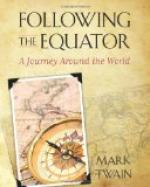I think he was going to hunt elephants with it, because I know, from remarks dropped by him, that he has hunted large game in India and Africa, and likes it. But I think that if he tries to hunt elephants with it, he is going to be disappointed.
I do not believe that it is suited for elephants. It lacks energy, it lacks force of character, it lacks bitterness. These things all show in the meekness and resignation of its expression. It would not attack an elephant, I am sure of it. It might not run if it saw one coming, but it looked to me like a dog that would sit down and pray.
I wish he had told me what breed it was, if there are others; but I shall know the dog next time, and then if I can bring myself to it I will put delicacy aside and ask. If I seem strangely interested in dogs, I have a reason for it; for a dog saved me from an embarrassing position once, and that has made me grateful to these animals; and if by study I could learn to tell some of the kinds from the others, I should be greatly pleased. I only know one kind apart, yet, and that is the kind that saved me that time. I always know that kind when I meet it, and if it is hungry or lost I take care of it. The matter happened in this way
It was years and years ago. I had received a note from Mr. Augustin Daly of the Fifth Avenue Theatre, asking me to call the next time I should be in New York. I was writing plays, in those days, and he was admiring them and trying to get me a chance to get them played in Siberia. I took the first train—the early one—the one that leaves Hartford at 8.29 in the morning. At New Haven I bought a paper, and found it filled with glaring display-lines about a “bench-show” there. I had often heard of bench-shows, but had never felt any interest in them, because I supposed they were lectures that were not well attended. It turned out, now, that it was not that, but a dog-show. There was a double-leaded column about the king-feature of this one, which was called a Saint Bernard, and was worth $10,000, and was known to be the largest and finest of his species in the world. I read all this with interest, because out of my school-boy readings I dimly remembered how the priests and pilgrims of St. Bernard used to go out in the storms and dig these dogs out of the snowdrifts when lost and exhausted, and give them brandy and save their lives, and drag them to the monastery and restore them with gruel.
Also, there was a picture of this prize-dog in the paper, a noble great creature with a benignant countenance, standing by a table. He was placed in that way so that one could get a right idea of his great dimensions. You could see that he was just a shade higher than the table—indeed, a huge fellow for a dog. Then there was a description which event into the details. It gave his enormous weight—150 1/2 pounds, and his length 4 feet 2 inches, from stem to stern-post; and his height—3 feet 1 inch, to the top of his back. The pictures and the figures so impressed me, that I could see the beautiful colossus before me, and I kept on thinking about him for the next two hours; then I reached New York, and he dropped out of my mind.




